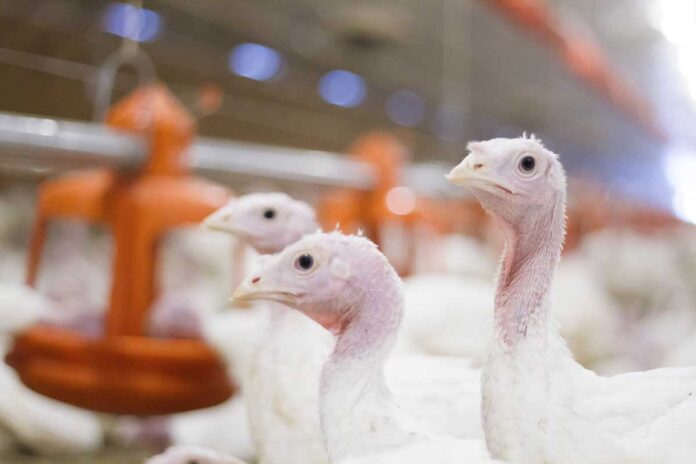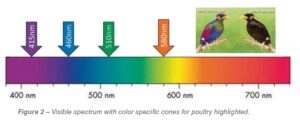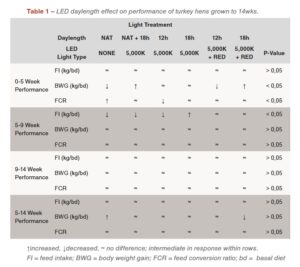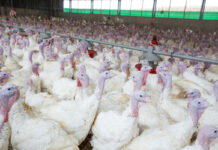
With the rise of the energy efficient light emitting diode – LED – bulbs in today’s market, there is an opportunity to refine lighting regiments to these new bulbs. Lighting studies involving monochromatic or mixed LEDs have been completed in quail, broilers, and layers, however, they have not been completed in turkeys. Although turkeys are markedly different from other poultry species with evidence that turkeys and broilers respond differently to lighting regiments, management decisions for turkeys are often based on information gained from broiler experiments. Therefore, the objective of this proceeding is to concisely report the effects of LED lighting regiments, specifically in turkey hens, raised at the Talley Turkey Educational Unit located in Raleigh, NC between the years 2016 and 2019.
What makes LEDs different than incandescent bulbs
Visible light is a small fraction of the electromagnetic spectrum nestled between shorter wavelengths with more energy: cosmic, gamma, x-ray, & ultraviolet, and longer wavelengths with less energy: infrared, radio, & electric waves. Traditional light occurs when heat is created causing energy to be emitted as perceived (visible) light. Incandescent bulbs work with this principle, and when an electrical current is run through a tungsten filament, heat is created, causing a glow to be emitted, producing light. Incandescent bulbs contain all the colors of the visible spectrum emitting a small amount of short wavelengths with high energy violets (380nm) and increasing amplitude towards the longer wavelengths with low energy reds (700nm) (Figure 1). Whereas LEDs produce light through a principle of electroluminescence, allowing them to emit very specific and precise wavelengths of light within the visual spectrum. Consumer LEDs are mixed colors and very few are monochromatic or emit only one wavelength of light. LEDs are also graded on a chromaticity scale, or color temperature expressed as a Kelvin (K) temperature (Figure 1).
 Color & intensity matter
Color & intensity matter
Chromaticity, or color temperature is very important when determining which type of LED to purchase. Different wavelengths emit different colored light and each color has an ability to penetrate through layers of the skin, allowing them to interact with tissues, including the retina. Poultry species have 4 types of cones (humans = 3) making them more sensitive to different colors including: violet (415nm), blue (460nm), green (510nm), and yellow/orange (560– 580nm) (Figure 2). During our studies, when common mixed LEDs (5,000K “blue” and 2,700K “yellow”) were dimmed from high intensities (10fc) to low intensities (2fc), the spectral output was altered in areas containing the sensitive color cones specific to poultry species.
 Lighting effects eye health
Lighting effects eye health
Turkeys require a higher intensity of light compared to chickens for proper eye development and welfare. If light intensity is too low in turkeys, eyes become elongated, causing myopia (blurriness), and if daylength is too long it can cause cataracts. In our studies, birds that were reared under 5,000K + RED LEDs (12h or 18h daylength) or under 5,000K LEDs (14h daylength) had elongation of the eyes. What is significant about these results is that spectral differences may be just as important in eye health as daylength and intensity effects.
Novelty in production
Novelty refers to experiences that are new which may elicit intrigue or fear in animals causing behavioral changes. In poultry, fear responses are associated with feather pecking, the bird’s ability to cope with social isolation, and their level of exploratory motivation. There were no differences between lighting groups based on their time to explore the novel items. At this time, behavioral footage is being reviewed to determine if there were differences between treatments with regards to types of behaviors displayed (i.e. eating, drinking, resting, walking, aggression, etc.).
Daylength effects turkey performance with LEDs
Most birds are photosensitive breeders, especially those used for meat production. This means that daylength initiates reproductive cycles in birds. These cycles can be altered by lighting causing birds to produce eggs year-round, semen to be collected, and to promote growth in meat production species. Our results (Table 1) indicate that sunlight + 18h of 5,000K LED increased body weight gain at 5 weeks of age. Whereas 18h of 5,000K LEDs with no sunlight increased feed intake from 5 – 9 weeks. However, there were no differences between treatments by the end of the study.
 Feather coverage
Feather coverage
Feathers are unique to birds and are an extension of the integumentary system plays a role in thermoregulation, insulation, and energy conservation. Feathers develop from keratinized epithelium derived from specialized follicles in the dermis. Infrared thermal imaging is an alternative way to access feather coverage based on heat signatures. A long daylength (18h), regardless of type of light was associated with a larger red signature over the breast tissue, indicative of less feather coverage. However, when birds were reared under 14 hrs of light, regardless of intensity level, there were no differences in feather coverage. Although a direct comparison cannot be made between our two studies, there was a 4% increase in feather coverage in our intensity study. At this time, we must further investigate the possible reasons for this increase in feather coverage. Is this simply due to natural variation between flocks or perhaps the introduction of novelty allowed birds to redirect their behaviors from feather pecking towards the objects?
Conclusion
Lighting regiments are necessary and include three main parameters: daylength, intensity, and chromaticity; all of which have been shown to impact bird physiology, behavior, well-being and performance in poultry. As LED lights continue to grow in popularity, additional studies must be completed to determine the effects in poultry management and may allow producers to establish a lighting program specific to their poultry needs. At this time novelty interactions must be further studied to determine if there was an added benefit to bird welfare as seen by a decrease in loss of feathers and possible reduction in aggression. As research moves forward, it is imperative to remember that turkeys may respond differently to lighting treatments than other types of poultry species and must be taken into consideration.
References are available on request
From the Proceedings of the Midwest Poultry Federation Convention
Cover photo by ©Mapi

















